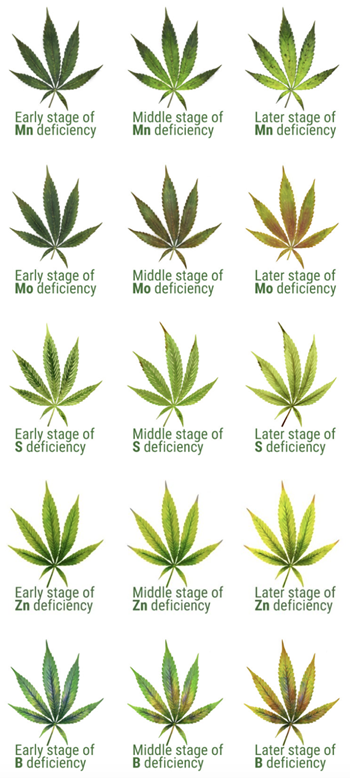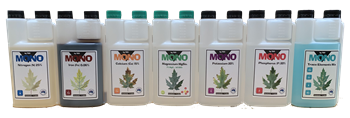THC Mono Trace Elements Mix
$50.00
THC Mono Trace Elements Mix

Essential trace elements are nutrients which are required by plants to survive, grow, and reproduce but are needed in only minute amounts.
Most common deficiency are likely to be zinc (Zn), copper (Cu), and manganese (Mn) than the other trace elements.
Of these three, Zn deficiency is probably the most important. Zn deficiency can severely limit production and reduce yields by up to 30 per cent. Cu deficiency is also important because it is capable of causing total crop failure.
There are other trace element deficiencies which can occur in crops and pastures (e.g. boron, molybdenum, iron, etc).
Trace elements are as essential to productive and profitable crops as nitrogen and phosphorus. The difference is that crops only require them in minute amounts. Zinc, manganese, or copper deficiencies are the most common and severe problems.
Trace element deficiencies are difficult to diagnose with soil tests or from plant symptoms. Plant testing is the most reliable, if not fool proof tool to diagnose trace element deficiencies.
Foliar sprays will usually correct a problem in crop. However, for long term correction of the deficiency boosting soil reserves is a sound investment.

TRACE ELEMENTS DEFICIENCY
There is variety of trace element deficiencies, including Molybdenum, Boron, Zinc, Manganese to name a few. All trace elements are in balance in all THC base mixes and are also available as a supplement in THC Mono Trace Elements mix.
Manganese (Mn) deficiency is a plant disorder that is often confused with, and occurs with, iron deficiency. Most common in poorly drained soils, also where organic matter levels are high. Manganese may be unavailable to plants where pH is high.
Symptoms include yellowing of leaves with smallest leaf veins remaining green to produce a ‘chequered’ effect. The plant may seem to grow away from the problem so that younger leaves may appear to be unaffected. Brown spots may appear on leaf surfaces, and severely affected leaves turn brown and wither.
Manganese deficiency can be easy to spot in plants because, much like magnesium deficiency, the leaves start to turn yellow and undergo interveinal chlorosis. The difference between these two is that the younger leaves near the top of the plant show symptoms first because manganese is not mobile while in magnesium deficiency show symptoms in older leaves near the bottom of the plant.
Molybdenum (Mo) deficiency occurs when plant growth is limited because the plant cannot take up sufficient quantities of this essential micronutrient from its growing medium. For crops growing in soil, this may be a result of low concentrations of Mo in the soil as a whole (i.e. the parent material of the soil is low in Mo), or because the soil Mo is held in forms that are not available to plants – absorption of Mo is strongest in acid soils.
In plants, the primary functions of Mo are related to the valence changes that it undergoes a component of enzymes that catalyse diverse redox reactions. A large number of Mo-deficiency disorders are associated with the disruption of the normal activity of several enzymes involved in nitrogen metabolism.
Molybdenum deficiency symptoms in most plants are associated with a build-up of nitrate in the affected plant part. This is a result of poor nitrate reductase activity. Symptoms include pale leaves with interveinal and marginal chlorosis (yellowing) and necrosis (scald), the whiptail disorder in Brassica crops (especially cauliflower), decreased tasselling in maize and premature germination of maize grain.
Zinc deficiency occurs when plant growth is limited because the plant cannot take up sufficient quantities of this essential micronutrient from its growing medium. It is one of the most widespread micronutrient deficiencies in crops and pastures worldwide and causes large losses in crop production and crop quality.
Zinc is an essential micronutrient which means it is essential for plant growth and development, but is required in very small quantities. Zinc requirements vary among crops.
Zinc deficiency symptoms include Chlorosis - yellowing of leaves; often interveinal; in some species, young leaves are the most affected, but in others both old and new leaves are chlorotic, Necrotic spots - death of leaf tissue on areas of chlorosis, Bronzing of leaves - chlorotic areas may turn bronze coloured, Rosetting of leaves - zinc-deficient dicotyledons often have shortened internodes, so leaves are clustered on the stem, Stunting of plants - small plants may occur as a result of reduced growth or because of reduced internode elongation, Dwarf leaves ('little leaf') - small leaves that often show chlorosis, necrotic spots or bronzing, Malformed leaves - leaves are often narrower or have wavy margins.
Boron deficiency is a common deficiency of the micronutrient boron in plants. It is the most widespread micronutrient deficiency around the world and causes large losses in crop production and crop quality. Boron deficiency affects vegetative and reproductive growth of plants, resulting in inhibition of cell expansion and reduced fertility.
Plants contain boron both in a water-soluble and insoluble form. In intact plants, the amount of water-soluble boron fluctuates with the amount of boron supplied, while insoluble boron does not. The appearance of boron deficiency coincides with the decrease of water-insoluble boron. It appears that the insoluble boron is the functional form while the soluble boron represents the surplus.
Boron is essential for the growth of higher plants. The primary function of the element is to provide structural integrity to the cell wall in plants. Other functions likely include the maintenance of the plasma membrane and other metabolic pathways.
To rectify this issues use THC Reskue or THC Mono Trace Elements and THC B-52.

Othe THC Mono mixes available.